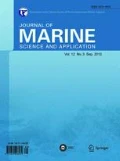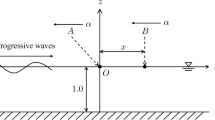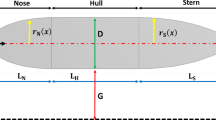Abstract
Reducing the fuel consumption of ships presents both economic and environmental gains. Although in the past decades, extensive studies were carried out on the flow around ship hull, it is still difficult to calculate the flow around the hull while considering propeller interaction. In this paper, the viscous flow around modern ship hulls is computed considering propeller action. In this analysis, the numerical investigation of flow around the ship is combined with propeller theory to simulate the hull-propeller interaction. Various longitudinal positions of the rudder are also analyzed to determine the effect of rudder position on propeller efficiency. First, a numerical study was performed around a bare hull using Shipflow computational fluid dynamics (CFD) code to determine free-surface wave elevation and resistance components. A zonal approach was applied to successively incorporate “potential flow solver” in the region outside the boundary layer and wake, “boundary layer solver” in the thin boundary layer region near the ship hull, and “Navier-Stokes solver” in the wake region. Propeller open water characteristics were determined using an open-source MATLAB code OpenProp, which is based on the lifting line theory, for the moderately loaded propeller. The obtained open water test results were specified in the flow module of Shipflow for self-propulsion tests. The velocity field behind the ship was recalculated into an effective wake and given to the propeller code that calculates the propeller load. Once the load was known, it was transferred to the Reynolds-averaged Navier-Stokes (RANS) solver to simulate the propeller action. The interaction between the hull and propeller with different rudder positions was then predicted to improve the propulsive efficiency.








































Similar content being viewed by others
References
Belhenniche S, Kadda B (2016) Numerical analysis of the turbulent flow around DTMB 4119 marine propeller. Int J Mar Environ Sci 10(2):347–351
Broberg L, Regnström B, Östberg M (2007) SHIPFLOW theoretical manual. FLOWTECH International AB, Gothenburg
Carrica PM, Castro AM, Stern F (2010) Self-propulsion computations using a speed controller and a discretized propeller with dynamic overset grids. J Mar Sci Technol 15:316–330. https://doi.org/10.1007/s00773-010-0098-6
Epps BP, Kimball RW (2013) OpenProp v3: open-source software for the design and analysis of marine propellers and horizontal-axis turbines. http://engineering.dartmouth.edu/epps/openprop (Accessed 22 May 2018)
Flood KM (2009) Propeller performance analysis using lifting line theory. M.Sc. thesis, Department of Mechanical Engineering, Massachusetts Institute of Technology, Cambridge. 1-60
Ghassemi H, Ghadimi P (2008) Computational hydrodynamic analysis of the propeller–rudder and the AZIPOD systems. Ocean Eng 35:117–130. https://doi.org/10.1016/j.oceaneng.2007.07.008
Gietz U, Kux J (1995) Flow investigations on the Hamburg test case model in the wind tunnel. Institute of Shipbuilding, University of Hamburg, Germany, Report No. 550, 1-52.
Karim MM, Naz N (2017) Computation of flow field around ship hull including self propulsion characteristics at varying rudder positions. Procedia Eng, 10th International Conference on Marine Technology, MARTEC 2016 194:96–103. https://doi.org/10.1016/j.proeng.2017.08.122
Kawabuchi, M, Kubota, M, Ishikawa, S (2016) Development of technology to estimate the flow field around ship hull considering wave making and propeller rotating effects. Mitsubishi Heavy Industries Technical Review, 53(2), 53–57.
Kayano J, Yabuki N, Sasaki N, Hiwatashi R (2013) A study on the propulsion performance in the actual sea by means of full-scale experiments. Trans Nav Int J Mar Navig Saf Sea Transp 7:521–526
Kim WJ, Van SH, Kim DH (2001) Measurement of flows around modern commercial ship models. Exp Fluids 31:567–578. https://doi.org/10.1007/s003480100332
Kim J, Kim KS, Kim GD, Park IR, Van SH (2006) Hybrid RANS and potential based numerical simulation for self-propulsion performances of the practical container ship. J Ship Ocean Technol 10:1–11
Koyama K (1972) A numerical analysis for the lifting surface theory of a marine propeller. J Soc Nav Architects Jpn 1972(132):91–98. https://doi.org/10.2534/jjasnaoe1968.1972.132_91
Krasilnikov VI (2013) Self-propulsion RANS computations with a single-screw container ship. Third International Symposium on Marine Propulsors, Launceston, Tasmania, 430–438.
Larsson L, Stern F, Visonneau M, Hirata N, Hino T, Kim J (2015) Proceedings of a Workshop on CFD in Ship Hydrodynamics. NMRI, Tokyo.
Menter FR (1994) Two-equation eddy-viscosity turbulence models for engineering applications. AIAA J 32:1598–1605. https://doi.org/10.2514/3.12149
Michell JH (1898) XI. The wave-resistance of a ship. Philos Mag 45:106–123. https://doi.org/10.1080/14786449808621111
Moraes HB, Vasconcellos JM, Latorre RG (2004) Wave resistance for high-speed catamarans. Ocean Eng 31:2253–2282. https://doi.org/10.1016/j.oceaneng.2004.03.012
Naz N, Karim MM (2017) Investigation of hydrodynamic characteristics of high speed multihull vessels including shallow water effect. Procedia Eng 194:51–58. https://doi.org/10.1016/j.proeng.2017.08.116
Øyan E (2012) Speed and powering prediction for ships based on model testing. M.Sc. Thesis, Dept. of Marine Technology, Norwegian University of Science and Technology
Phillips AB, Turnock SR, Furlong M (2008) Comparisons of CFD simulations and in-service data for the self propelled performance of an autonomous underwater vehicle. 27th Symposium on Naval Hydrodynamics. 2:951-965, Seoul.
Rijpkema D, Starke B, Bosschers J (2013) Numerical simulation of propeller-hull interaction and determination of the effective wake field using a hybrid RANS-BEM approach. Third International Symposium on Marine Propulsors, SMP2013, Launceston, 421–429
Sakamoto N, Kume K (2016) Numerical towing tank procedure for JBC in self-propulsion with rotating propeller and energy saving duct. 2016 JASNAOE Spring Annual Meeting, Fukuoka.
Sezen S, Dogrul A, Delen C, Bal S (2018) Investigation of self-propulsion of DARPA suboff by RANS method. Ocean Eng 150:258–271. https://doi.org/10.1016/j.oceaneng.2017.12.051
Stern F, Kim HT (1994) Computation of viscous flow around propeller-body configurations: series 60 CB= 0.6 Ship Model. J Ship Res 38(2):137–157
Takeshi H, Hino T, Hinatsu M, Tsukada Y, Fujisawa J (1987) ITTC cooperative expreiments on series 60 model at ship research institute–flow measurements and resistance tests, vol Supp. 9. Ship Research Institute, Japan, 1-481–48
Tezdogan T, Demirel YK, Kellett P, Khorasanchi M, Incecik A, Turan O (2015) Full-scale unsteady RANS CFD simulations of ship behaviour and performance in head seas due to slow steaming. Ocean Eng 97:186-206. doi: 10.1016/j.oceaneng.2015.01.011
Zhang, D (1990) Numerical Computation of Ship Stern/Propeller Flow. PhD thesis, Department of Shipping and Marine Technology, Chalmers University of Technology, Gothenburg.
Funding
Authors acknowledge the Committee for Advanced Studies and Research (CASR), Bangladesh University of Engineering and Technology for granting research fund and sub-project CP No. 2084 of Department of Naval Architecture and Marine Engineering under Higher Education Quality Enhancement Project (HEQEP), UGC, Ministry of Education, Govt. of Bangladesh for providing necessary research facilities during the current research work.
Author information
Authors and Affiliations
Corresponding author
Additional information
Article Highlights
• To ensure economic and environmental gains, the flow around ship hull must be analyzed considering the rudder-propeller interaction.
• Flow around two different modern ship hulls with the presence of propellers has been numerically studied at different longitudinal positions of the rudder.
• The zonal approach has been implemented to incorporate the combined effect of the flow around ship hull with the rudder and propeller interaction.
• The propeller and hull efficiencies can be improved by increasing the longitudinal position of the rudder from the propeller which leads to reduced interaction effect.
Rights and permissions
About this article
Cite this article
Karim, M.M., Naz, N. Numerical Study on Flow Around Modern Ship Hulls with Rudder-Propeller Interactions. J. Marine. Sci. Appl. 18, 400–416 (2019). https://doi.org/10.1007/s11804-019-00113-6
Received:
Accepted:
Published:
Issue Date:
DOI: https://doi.org/10.1007/s11804-019-00113-6




